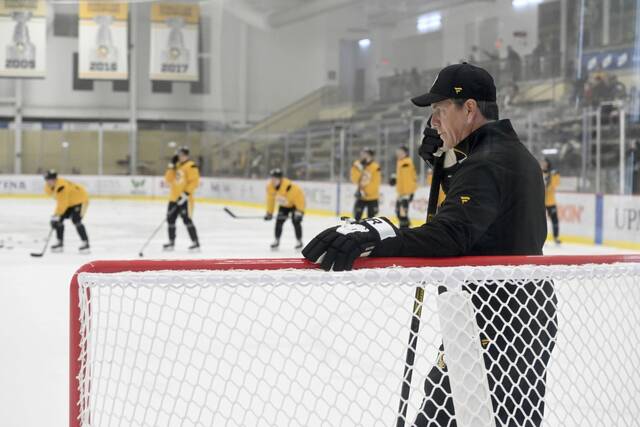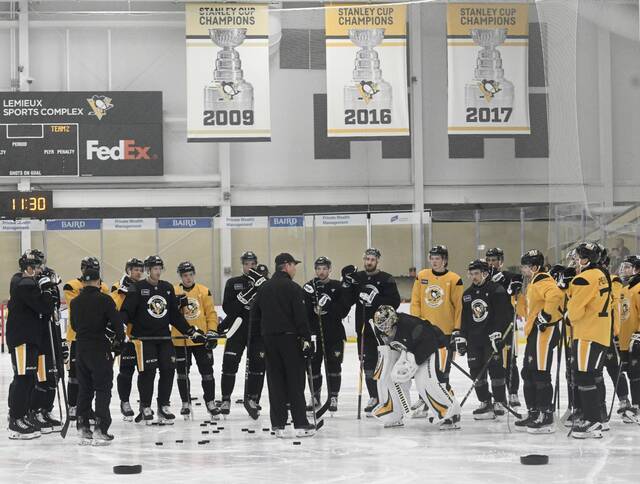Tim Benz: Penguins saying all the right things about fixing the power play — now, make it happen
I asked Pittsburgh Penguins captain Sidney Crosby about the importance of improving the power play during an interview on Day 1 of training camp.
“You’re bringing it up. We haven’t even practiced it yet. That tells you how many eyes are on it,” Crosby replied.
Indeed.
On Monday, all eyes were watching when the Pens had their first extensive work on the man-up unit that was tragically flawed a year ago. It converted just 15.3% of the time in 2023-24.
“We know it was something that we could’ve done much better last year,” Crosby said. “You’ve got to put the puck in the back of the net. If we score goals, we don’t have to answer about it. It’s a process. You have to go out there and understand where you have to be.”
This season, a new assistant coach is in charge of that process. It’s former San Jose Sharks head coach David Quinn. He replaced Todd Reirden after the Pens finished 30th out of 32 NHL teams in power play percentage.
“We had our first video session today. He has some great ideas. I’m excited to see where it goes,” forward Rickard Rakell said Monday. “Get everybody on the same page. Take advantage of the fact that we have one more player out there. (Get) everybody to know their job and their role and execute. … When we sit down and spend a lot of time working on it, I think it is going to be great.”
Rakell was on the top unit Monday along with Crosby, Evgeni Malkin, Bryan Rust and Kris Letang. Malkin seemed to find his way in front of the net a little bit more often than normal with Crosby swapping into the right circle. Michael Bunting was on the second unit. He showed some promise in the bumper position a year ago after being acquired from Carolina.
Head coach Mike Sullivan was asked if we should read anything into player deployment or structure from the power play at Monday’s practice.
“Nothing,” he replied.
That seems like more than just a coach-speak “nothing to see here” response, given that defenseman Erik Karlsson is injured. Despite last year’s lousy results, Karlsson is once again expected to quarterback the power play unit even though — as general manager Kyle Dubas so beautifully put it after last season ended — Karlsson tried to “slap pass it through five people every time” during his first year as a Penguin.
More sports
• Talk of the town: After 2-sack game, Herbig likely to be deployed more by Steelers
• Penguins defenseman Ryan Graves: 'I know that I’m still a good player'
• Steelers OLB Alex Highsmith frustrated to be dealing with another groin injury
Rather than dwell on personnel choices and player positioning on the ice, Sullivan instead shined a light on one area of power play performance that he wants to see the team dramatically improve and another where he thinks it can naturally excel.
The first is executing offensive-zone entries.
“It certainly wasn’t a strength of the group (a year ago),” Sullivan said. “If you look back at the history of our power plays over the time we’ve been here, I don’t think entries have ever been the strength of our group. It’s an opportunity for us to get better.
“If you can win faceoffs, you can establish zone time, then give your power play an opportunity to do what they do best. If you don’t win faceoffs, or you aren’t successful on entries, then you can’t establish zone time. Those two elements are a really important aspect of setting your power play up for success.”
Another is puck retrieval. That’s an aspect of the game where Sullivan thinks the Pens should be able to thrive because of players such as Rust and Crosby.
“If you look at how a lot of goals are scored around the league, there is a lot of offense that can be created out of those situations, those retrievals,” Sullivan said. “Usually, when you win those pucks, your opponents are out of the structure that they have. There is opportunity there if we can retrieve pucks and have success and have a quick-strike mindset.
“That’s when our guys are at their best because it is instinctive play. It’s not any setup framework or set play where we are trying to make this highlight-reel goal and we are going to pass it in the net. It’s just hockey.”
Rust seems to agree.
“Predictable to us, unpredictable to (the opponent) is the mindset we need to adopt,” Rust said. “A little bit more simplicity in getting pucks and bodies to the net. I think there were times where things were a little bit overdone with too many passes. We just have to work hard and simplify.”
That makes plenty of sense. Now it’s a matter of getting the players to buy in.
Maybe it’s in the messaging. To Sullivan’s point, maybe it’s about reinforcing to the players that their natural skills are some of the best to ever play the game. So stop trying to work so hard to make a set play from a whiteboard look so pretty.
Create a highlight organically like great players do instead of trying to pay off some structural coaching vision of a tic-tac-toe design.
If Sullivan and Reirden couldn’t get that point across last year, maybe Quinn can this year. Or maybe Karlsson will have an epiphany. Or perhaps Quinn can figure out a better way to deploy and heighten the skills these aging Penguins stars still have.
Whatever the case, the pathetic power play single-handedly crushed the Penguins’ 2023-24 season. If the team finally wants to get back to the playoffs and win a round for the first time since 2018, it has to be an asset — not a detractor.
Tim Benz is a Tribune-Review staff writer. You can contact Tim at tbenz@triblive.com or via X. All tweets could be reposted. All emails are subject to publication unless specified otherwise.
Remove the ads from your TribLIVE reading experience but still support the journalists who create the content with TribLIVE Ad-Free.



